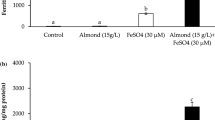Summary
Background: In spite of the strong evidence for the beneficial heath effects of dietary fibres, one of the potential nutritional disadvantages of high fibre diets is the adverse effect on the bioavailability of micronutrients, especially minerals and trace elements. With regard to Ca, there is considerable evidence that phytate, which is associated with fibre in many foods, such as cereals and soya products, inhibits Ca absorption. However, there is some doubt as to whether fibres per se have an influence on Ca absorption.
Aim of the study: Therefore, the purpose of this study was to investigate the effect on Ca absorption of two cereal-based fibre extracts (wheat bran and barley hull). In addition, in order to distinguish between the effect of the fibre components per se and the associated phytate content in these fibre extracts, we investigated the effect of dephytinised wheat and barley fibre extracts and the effect of phytate, as sodium phytate at levels present in the fibre extracts, on Ca absorption. Ca absorption was assessed in Caco-2 cells, as a model for studying Ca absorption in humans.
Methods: The effect of wheat and barley fibre extracts, dephytinised wheat and barley fibre extracts, cellulose, and of sodium phytate on transepithelial 45Ca transport and 45Ca uptake was studied in differentiated Caco-2 cells grown on permeable filter supports. Wheat and barley fibre extracts were dephytinised with wheat phytase.
Results: Wheat fibre extract had a 3.2-fold higher phytate content (48.0 mmol/kg) than barely fibre extract (15.1 mmol/kg). Enzymatic dephytinisation of both fibre extracts reduced the phytate content to undetectable levels. The rate of transepithelial 45Ca transport across Caco-2 cell monolavers and the uptake of 45Ca into Caco-2 cells were unaffected by cellulose or barley fibre extract. On the other hand, inclusion of wheat fibre extract in the Ca transport buffer (50 g fibre/l) significantly reduced the rate of 45Ca transport (by 17 and 19% respectively) and the uptake of 45Ca (by 24 and 25% respectively) relative to a fibre-free buffer and a control fibre (cellulose) transport buffer. Increasing the phytate concentration of the transport buffer from 0 to 2 mM (a level close to that in the wheat fibre containing buffer) significantly reduced the rate of 45Ca transport (by 16%) and 45Ca uptake (by 26%). Dephytinisation of the wheat fibre extract removed its inhibitory effects on 45Ca transport and e. g. 45Ca uptake.
Conclusion: The results from the present study in Caco-2 cells suggest that it is the phytate in wheat fibre extract which is the major inhibitory factor of Ca absorption and that wheat fibre per se has little if any inhibitory effect on Ca absorption. In addition, the results of this study support the usefulness of Caco-2 cells for investigating the effects of dietary factors on the cellular uptake and transepithelial intestinal transport of Ca.
Similar content being viewed by others
Author information
Authors and Affiliations
Additional information
Received: 22 March 1999, Accepted: 2 February 2000
Rights and permissions
About this article
Cite this article
Kennefick, S., Cashman, K. Inhibitory effect of wheat fibre extract on calcium absorption in Caco-2 cells: evidence for a role of associated phytate rather than fibre per se. Eur J Nutr 39, 12–17 (2000). https://doi.org/10.1007/s003940050071
Issue Date:
DOI: https://doi.org/10.1007/s003940050071




